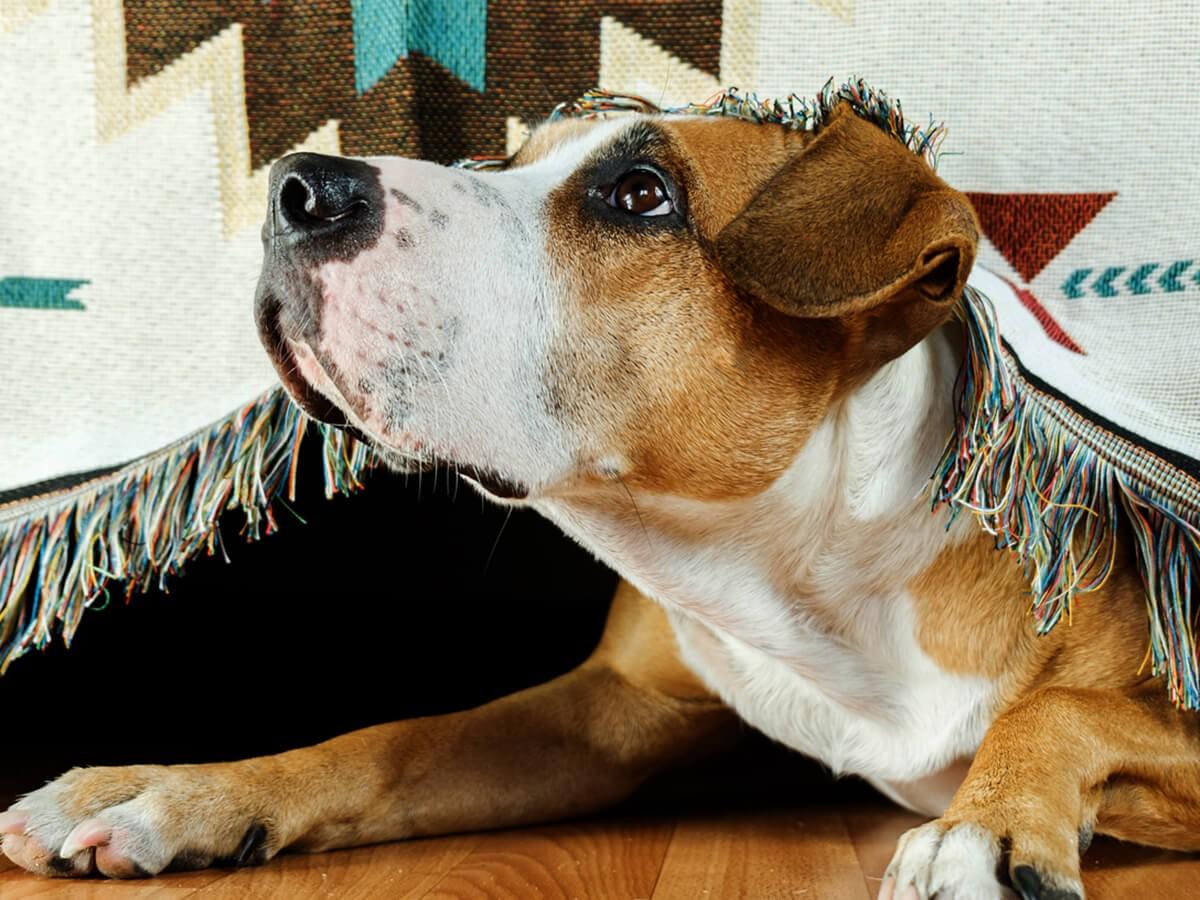Why Dogs Are Scared of Fireworks
Fireworks trigger a fight-or-flight response in many dogs. Studies show over 52 % of dogs are fearful of fireworks1. The loud booms, bright flashes, and unpredictability can provoke intense anxiety, leading to shaking, panting, pacing, or even escape attempts. Rest assured that Spot Pet Insurance is here to help provide tips to keep everyone calm and happy.
Preparing your pet for fireworks
Helping your dog stay calm during fireworks doesn't have to be overwhelming. Whether your pup is mildly anxious or extremely fearful, the key is preparation. Below are three tips you can use to create a safer, more comforting environment during firework season, ranging from setting up a quiet space to exploring calming supports and long-term training techniques.
1. Create a “Safe Room” with comforting features.
Start by setting up a quiet, secure space where your pet can retreat during fireworks. Both dogs and cats have a natural fight-or-flight response to loud, unpredictable noises. An interior windowless room—like a basement, bathroom, or closet—works best. To muffle the noise, add white noise with a fan, dryer, or TV.
Include familiar comforts like a cozy bed, a blanket with your scent, or an anxiety wrap like a ThunderShirt. If possible, stay with your pet to offer calming reassurance.
Safe room shortlist:
A cozy bed or a crate
White noise (fan, dryer, music)
Anxiety wrap (e.g., ThunderShirt)
A clothing item with your scent
2. Ask Your Vet About Calming Supports
For pets with severe anxiety, medication may be a helpful last resort. Some pet parents also explore CBD oil, though studies on its effects in pets are limited. The American Kennel Club recommends consulting your vet before trying CBD, sedatives, or any homeopathic remedies.
Medication shortlist:
Consult your vet about a prescription medication (e.g., trazodone, dexmedetomidine, Sileo)
Consider veterinarian-approved nutraceuticals (tryptophan, valerian, passiflora), which show reduced cortisol and anxiety during fireworks.
Note: Homeopathic supplements or CBD may offer anecdotal relief, but scientific support is limited.
3. Train with Desensitization & Counterconditioning
I spoke with a trainer named Sam, who shared his most effective method for helping dogs cope with fireworks—one that also works for thunder. He uses a technique called “successive approximation,” which involves gradually exposing the dog to the sound while pairing it with distractions and rewards.
Sam’s go-to reward is a game of tug, which taps into the dog’s natural prey drive. While food treats can be effective for some pups, most dogs respond well when their prey drive is engaged. The goal is to shift their focus from a fight-or-flight response to playful engagement.
Here’s how you can try it:
Download fireworks sounds onto a device where you can control the volume, or find a long fireworks video on YouTube.
Start playing the sounds at a very low volume and gradually increase them. Having a second person can help, so you can fully focus on your dog.
Play tug with a rope or pull toy, keeping your dog’s attention on you. Aim for high engagement—even growling shows they’re into the game.
If your dog becomes distracted by the sound or shows signs of anxiety, lower the volume and refocus them on the game. Continue slowly increasing volume as they stay engaged.
This technique is especially helpful for puppies, as it helps them get used to loud sounds early on.
Another helpful strategy is desensitization—playing firework sounds at a level “below the threshold,” where your dog can hear them without becoming anxious. As they get more comfortable, you can gradually raise the volume, always watching closely for stress signals and turning it down if needed.
When in doubt, consult a certified pet trainer or veterinary behaviorist. You know your dog best—so trust your instincts and take things at a pace that works for both of you. Starting training early (before fear sets in) yields the best outcomes, though it's never too late to start.
More Tips From Pet Parents
“Trazadone was a game-changer for us.”
“Sedatives didn’t do anything for our dog, but homeopathic formulas worked.”
“Thunder shirt didn’t work, but my husband’s shirt tied around the dog did. It must have felt like a hug.”
Safety Note
Around fireworks events, shelters report an 81 % spike in lost pet incidents2. Ensure your dog is microchipped and wears an up-to-date collar ID.
FAQ
Q: What’s the best way to calm a dog during fireworks?
A: Create a quiet, enclosed safe room, use white noise, anxiety wraps, and consult a vet for behavior training or medication if needed.Q: Do thunder jackets really help?
A: Yes—studies show tight wraps reduce stress in 89 % of cases 3. Effectiveness improves when used with other strategies.Q: When should I consider medication or medication alternatives?
A: For severe anxiety—shaking, panicking, escape attempts—speak to a vet about prescription meds or veterinary-grade supplements to support behavior work .Q: Can training really reduce firework anxiety?
A: Absolutely. Desensitization and counterconditioning can help dogs with a fear of fireworks, especially when started early1.
Key Takeaways
You’re a proactive pet parent—creating a safe, reassuring environment and pairing it with behavior training is the best approach to helping your dog overcome firework fear. Combine environmental controls, actionable vet advice, and focused training to reduce noise phobia and improve your dog’s overall quality of life.

Creative manager by day, pet enthusiast all the time! After 19 years with my dog (hopefully he wins the award for oldest pet in the world), I enjoy spending my days brainstorming tail-wagging content, and sniffing out the latest trends in the pet world.
Lombardi, Linda. “Fireworks Fears Can Change over Time, Study Shows.” Fear Free Pets, fearfreepets.com/fireworks-fears-can-change-over-time-study-shows/.
Mallenbaum, Carly. “How to Calm Scared Dogs during Fireworks Shows.” Axios, 30 June 2023, www.axios.com/2023/06/30/fireworks-dog-scared-how-to-calm.
Mathis, Savannah, et al. “A Systematic Review of the Efficacy of Compression Wraps as an Anxiolytic in Domesticated Dogs.” Animals, vol. 14, no. 23, 28 Nov. 2024, p. 3445, https://doi.org/10.3390/ani14233445.












